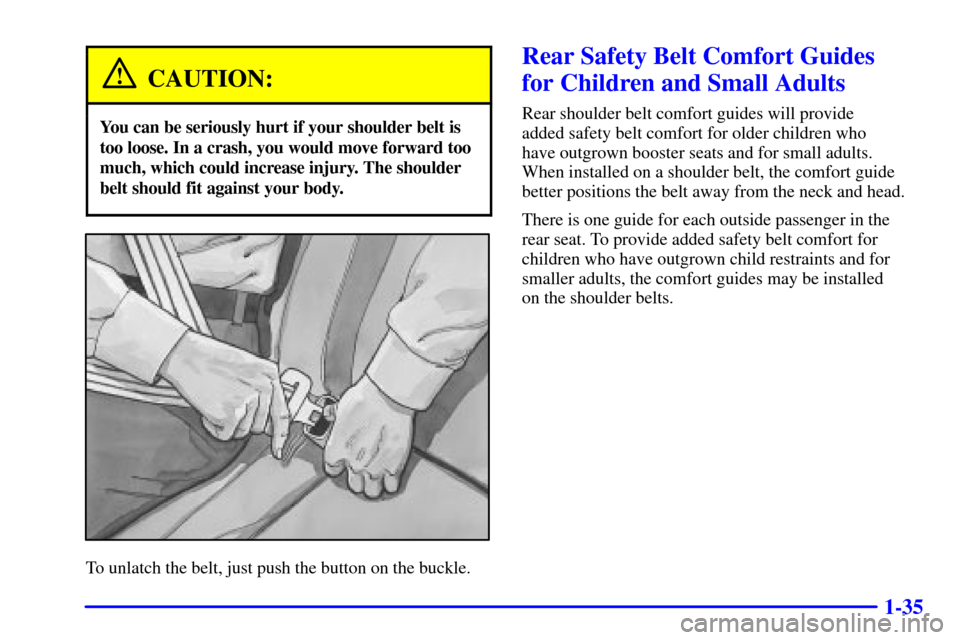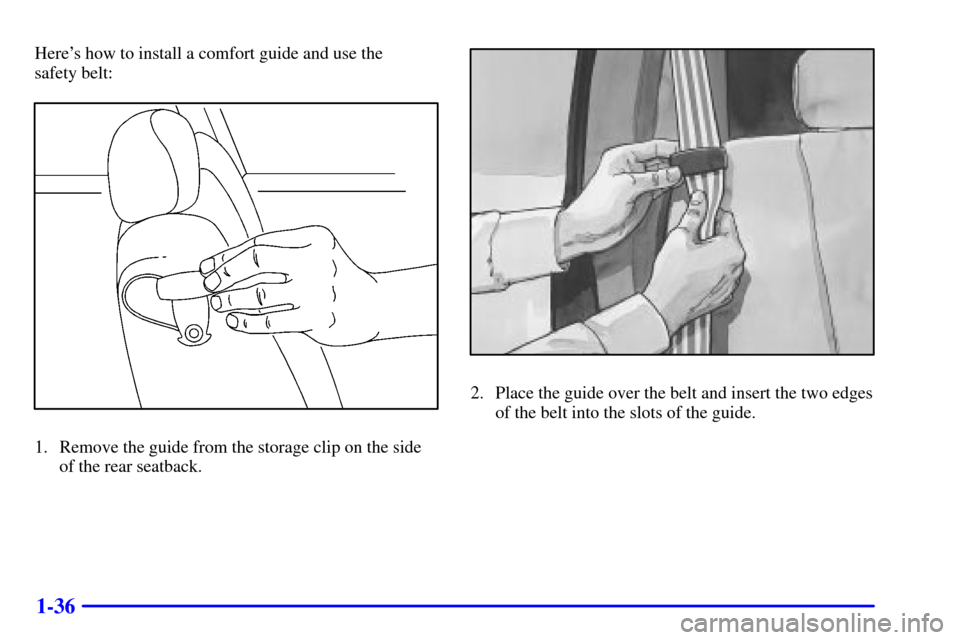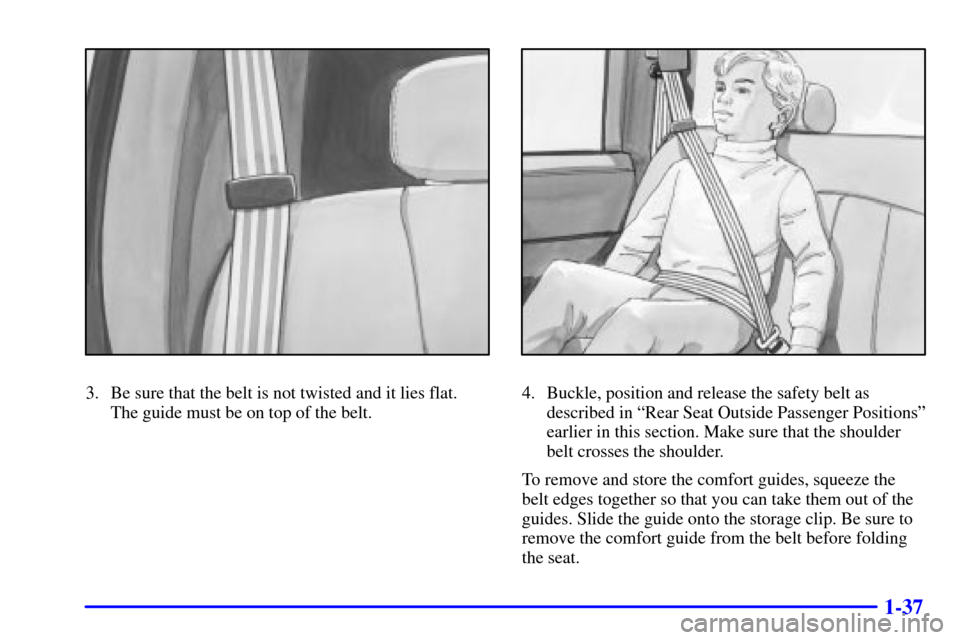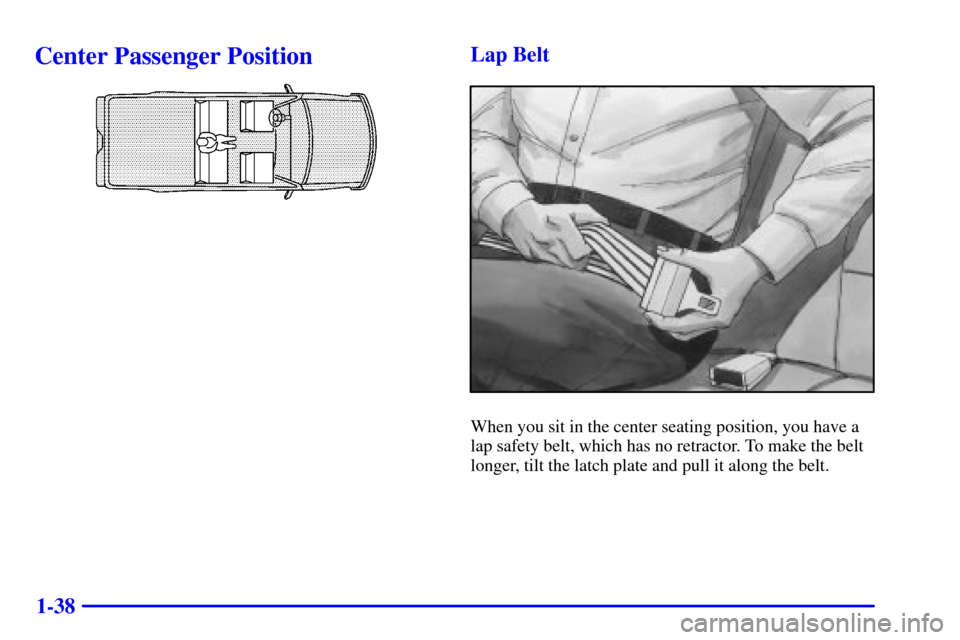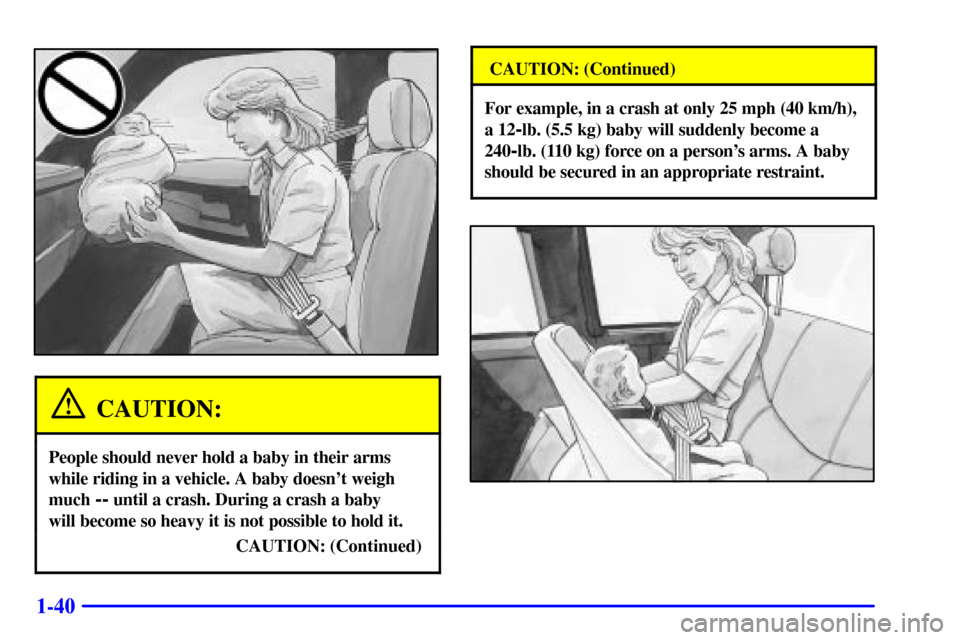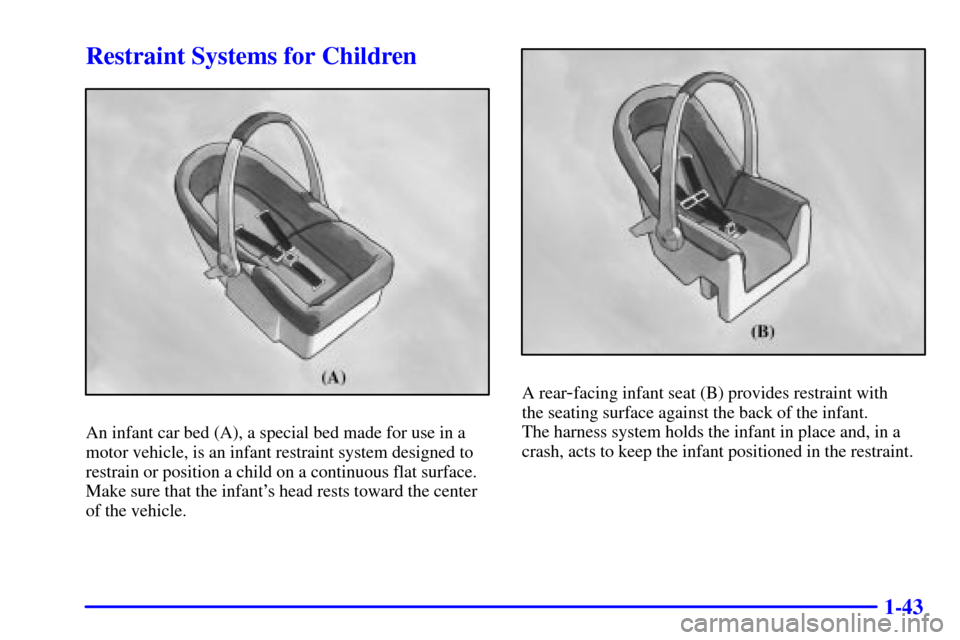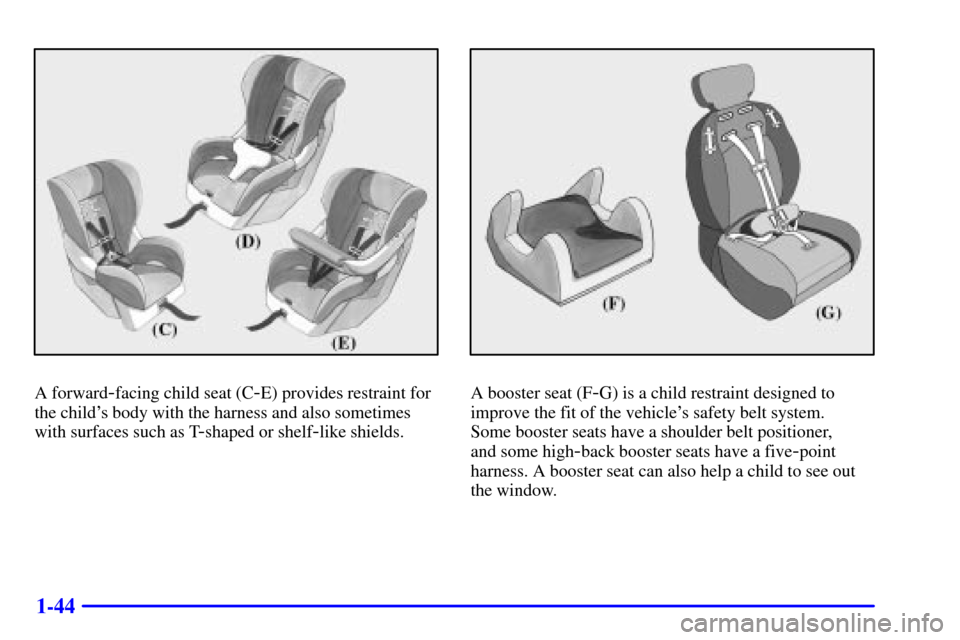CADILLAC ESCALADE EXT 2002 2.G Service Manual
ESCALADE EXT 2002 2.G
CADILLAC
CADILLAC
https://www.carmanualsonline.info/img/23/7924/w960_7924-0.png
CADILLAC ESCALADE EXT 2002 2.G Service Manual
Trending: winter tires, sunroof, Oil capacities, horn, brake pads, octane, steering
Page 41 of 427
1-35
CAUTION:
You can be seriously hurt if your shoulder belt is
too loose. In a crash, you would move forward too
much, which could increase injury. The shoulder
belt should fit against your body.
To unlatch the belt, just push the button on the buckle.
Rear Safety Belt Comfort Guides
for Children and Small Adults
Rear shoulder belt comfort guides will provide
added safety belt comfort for older children who
have outgrown booster seats and for small adults.
When installed on a shoulder belt, the comfort guide
better positions the belt away from the neck and head.
There is one guide for each outside passenger in the
rear seat. To provide added safety belt comfort for
children who have outgrown child restraints and for
smaller adults, the comfort guides may be installed
on the shoulder belts.
Page 42 of 427
1-36
Here's how to install a comfort guide and use the
safety belt:
1. Remove the guide from the storage clip on the side
of the rear seatback.
2. Place the guide over the belt and insert the two edges
of the belt into the slots of the guide.
Page 43 of 427
1-37
3. Be sure that the belt is not twisted and it lies flat.
The guide must be on top of the belt.4. Buckle, position and release the safety belt as
described in ªRear Seat Outside Passenger Positionsº
earlier in this section. Make sure that the shoulder
belt crosses the shoulder.
To remove and store the comfort guides, squeeze the
belt edges together so that you can take them out of the
guides. Slide the guide onto the storage clip. Be sure to
remove the comfort guide from the belt before folding
the seat.
Page 44 of 427
1-38
Center Passenger PositionLap Belt
When you sit in the center seating position, you have a
lap safety belt, which has no retractor. To make the belt
longer, tilt the latch plate and pull it along the belt.
Page 45 of 427
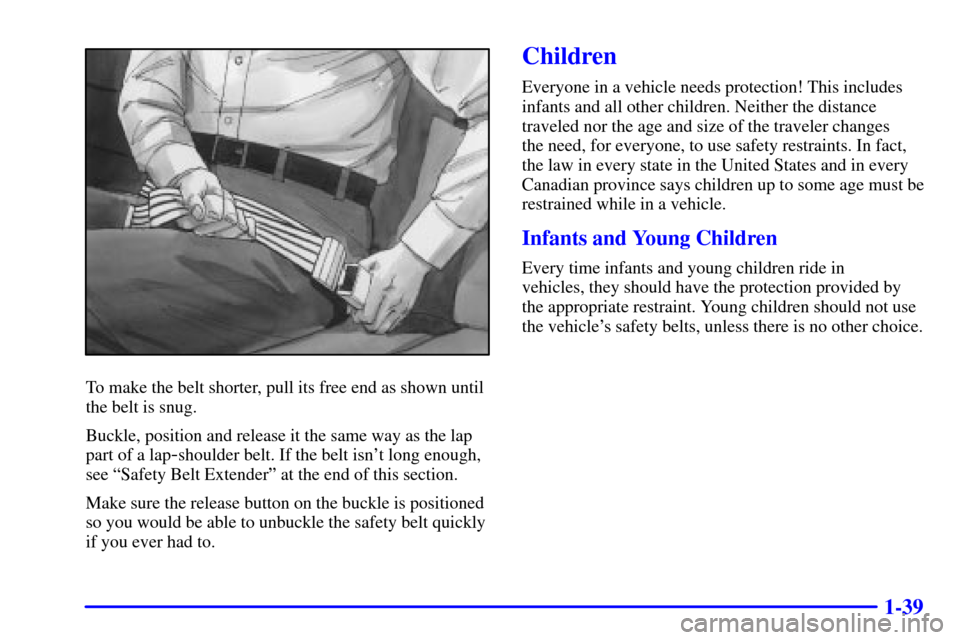
1-39
To make the belt shorter, pull its free end as shown until
the belt is snug.
Buckle, position and release it the same way as the lap
part of a lap
-shoulder belt. If the belt isn't long enough,
see ªSafety Belt Extenderº at the end of this section.
Make sure the release button on the buckle is positioned
so you would be able to unbuckle the safety belt quickly
if you ever had to.
Children
Everyone in a vehicle needs protection! This includes
infants and all other children. Neither the distance
traveled nor the age and size of the traveler changes
the need, for everyone, to use safety restraints. In fact,
the law in every state in the United States and in every
Canadian province says children up to some age must be
restrained while in a vehicle.
Infants and Young Children
Every time infants and young children ride in
vehicles, they should have the protection provided by
the appropriate restraint. Young children should not use
the vehicle's safety belts, unless there is no other choice.
Page 46 of 427
1-40
CAUTION:
People should never hold a baby in their arms
while riding in a vehicle. A baby doesn't weigh
much
-- until a crash. During a crash a baby
will become so heavy it is not possible to hold it.
CAUTION: (Continued)
CAUTION: (Continued)
For example, in a crash at only 25 mph (40 km/h),
a 12
-lb. (5.5 kg) baby will suddenly become a
240
-lb. (110 kg) force on a person's arms. A baby
should be secured in an appropriate restraint.
Page 47 of 427
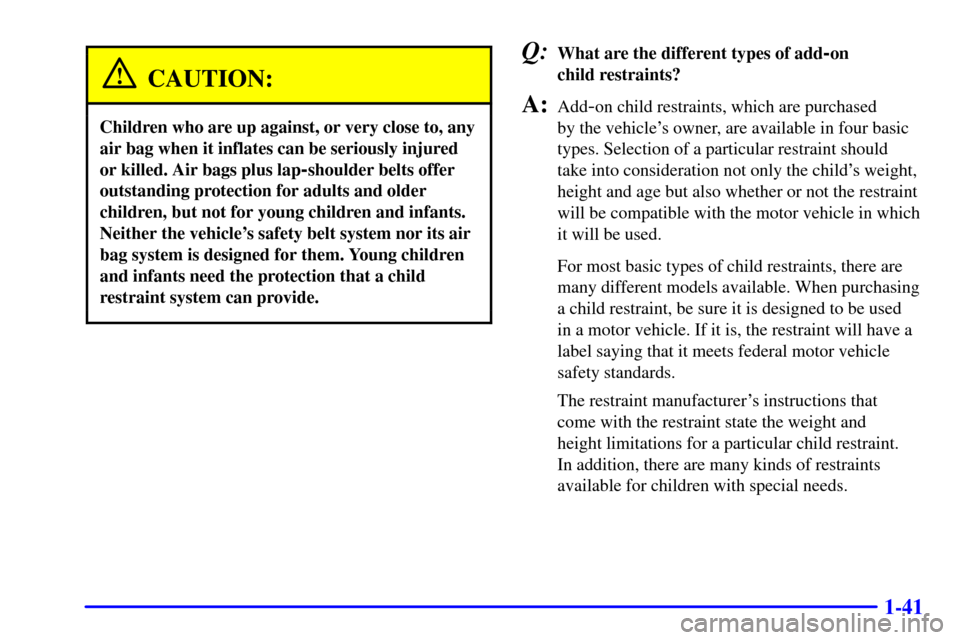
1-41
CAUTION:
Children who are up against, or very close to, any
air bag when it inflates can be seriously injured
or killed. Air bags plus lap
-shoulder belts offer
outstanding protection for adults and older
children, but not for young children and infants.
Neither the vehicle's safety belt system nor its air
bag system is designed for them. Young children
and infants need the protection that a child
restraint system can provide.
Q:What are the different types of add-on
child restraints?
A:Add-on child restraints, which are purchased
by the vehicle's owner, are available in four basic
types. Selection of a particular restraint should
take into consideration not only the child's weight,
height and age but also whether or not the restraint
will be compatible with the motor vehicle in which
it will be used.
For most basic types of child restraints, there are
many different models available. When purchasing
a child restraint, be sure it is designed to be used
in a motor vehicle. If it is, the restraint will have a
label saying that it meets federal motor vehicle
safety standards.
The restraint manufacturer's instructions that
come with the restraint state the weight and
height limitations for a particular child restraint.
In addition, there are many kinds of restraints
available for children with special needs.
Page 48 of 427
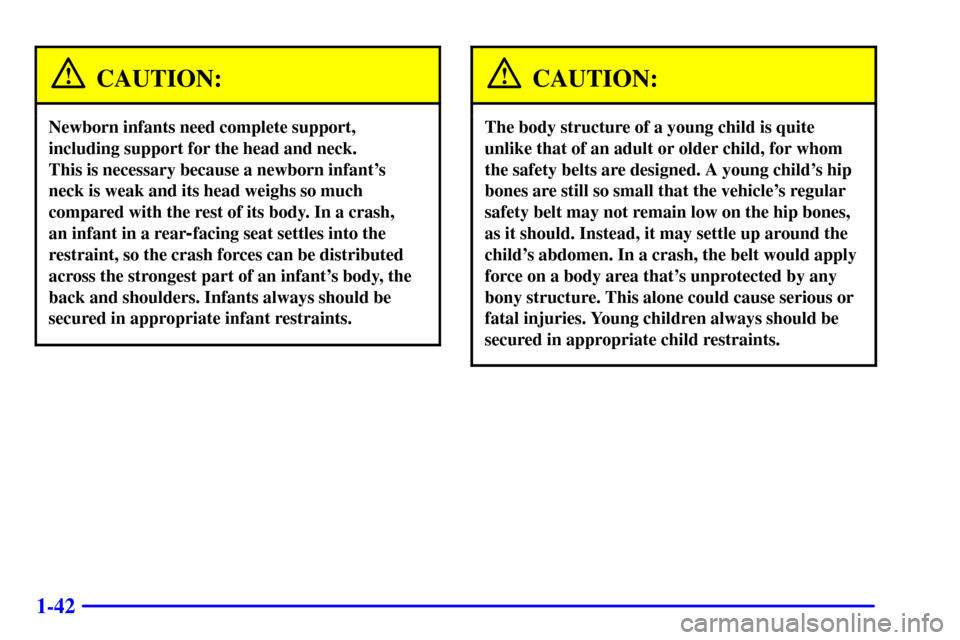
1-42
CAUTION:
Newborn infants need complete support,
including support for the head and neck.
This is necessary because a newborn infant's
neck is weak and its head weighs so much
compared with the rest of its body. In a crash,
an infant in a rear
-facing seat settles into the
restraint, so the crash forces can be distributed
across the strongest part of an infant's body, the
back and shoulders. Infants always should be
secured in appropriate infant restraints.
CAUTION:
The body structure of a young child is quite
unlike that of an adult or older child, for whom
the safety belts are designed. A young child's hip
bones are still so small that the vehicle's regular
safety belt may not remain low on the hip bones,
as it should. Instead, it may settle up around the
child's abdomen. In a crash, the belt would apply
force on a body area that's unprotected by any
bony structure. This alone could cause serious or
fatal injuries. Young children always should be
secured in appropriate child restraints.
Page 49 of 427
1-43
Restraint Systems for Children
An infant car bed (A), a special bed made for use in a
motor vehicle, is an infant restraint system designed to
restrain or position a child on a continuous flat surface.
Make sure that the infant's head rests toward the center
of the vehicle.
A rear-facing infant seat (B) provides restraint with
the seating surface against the back of the infant.
The harness system holds the infant in place and, in a
crash, acts to keep the infant positioned in the restraint.
Page 50 of 427
1-44
A forward-facing child seat (C-E) provides restraint for
the child's body with the harness and also sometimes
with surfaces such as T
-shaped or shelf-like shields.
A booster seat (F-G) is a child restraint designed to
improve the fit of the vehicle's safety belt system.
Some booster seats have a shoulder belt positioner,
and some high
-back booster seats have a five-point
harness. A booster seat can also help a child to see out
the window.
Trending: seats, Tire change, wiper blades, automatic transmission, service, load capacity, change language
